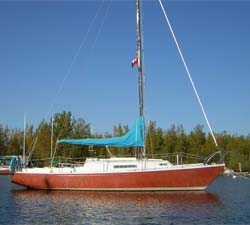Viking 28
 By Paul Howard
By Paul Howard
“We wanted a good-looking, smart-sailing boat with berths for four,” said George Cuthbertson, the leader of the C&C team that designed the Viking 28. “But, we made a conscious decision not to distort the lines of this racer/cruiser in order to create headroom.” Considering the fact that Cuthbertson is 6 ft 4in., a 28-footer with headroom enough for his frame would have been very top-heavy.
The Viking was the first of the C&C-designed Viking series built by Ontario Yachts in Oakville, Ontario. Later, this shop added the Viking 22, 33 and a modified 33 renamed as the Viking 34. Interestingly, in the early ’70s the Viking 28 made its way overseas when it was built by Anesty Yachts in England and renamed the Trapper 28. Seventy of these Euro-Vikings were built along with a number of other C&C designs including the C&C 27, called the Trapper 27, and the C&C 35.
About 147 Viking 28s were built by Ontario Yachts between 1968 and 1983. Although initially offered in kit form, many subsequent Vikings were professionally finished. A number of modifications to the design were made in 1974, and included the addition of a pop-top hatch and a wider companionway. At the same time, the mast step area and vee-berth were altered to strengthen the hull. The Viking 28 was available with either an outboard engine in a well in the lazarette, or with a 7 hp Vire two-cycle gasolene inboard.
At 28 ft 2 in. LOA and 4,755 lbs, the Viking was considerably lighter for its size than most designs at that time. Cuthbertson comments that, “at 47 per cent ballast (with 2,250 lbs. of cast iron in a 4 ft 6 in. fin keel), she was heavily ballasted for her day.”
In the 1970s the Viking 28 was popular as both a one design and as a performance cruiser. Several Lake Ontario clubs established fleets of these boats, with the Royal Hamilton Yacht Club having had the largest and best known congregation. A half-hull model still hangs over the bar at the clubhouse where early fleets are honoured. Indeed, the Viking 28 played an important role in the racing programme at the RHYC, as the boat was affordable, easy to handle with a mixed crew, yet also offered good racing performance and a moderate cruising interior. Thee RHYC members boosted the early fleet by purchasing boats at the same time and naming them after their favourite liquours. Crown Royal has a purple hull, Irish Mist a green hull and MaiTai is yellow and blue.
I sailed a weekday evening race with Peter Kozak, a member of the Toronto Sailing and Canoe Club and owner of Victory Hunter — one of the last Vikings built. Victory Hunter’s hull profile immediately identified it as a classic C&C design with a high bow, easy sheer, a moderate overhang aft and a reverse sheer transom. The topsides are low compared to most C&C designs and the boat looks classy, with great eye appeal.
A narrow but long cockpit is split by the main traveller, with the mainsail trimmer located aft of the helmperson. The tiller, which leads to a swept spade rudder, is forward, with the helmsperson located near the winches and although narrow, the cockpit is workable.
With a pick-up crew of four struggling to get the lines led correctly, we headed out for the race course. There were four of the TS&CC’s five Vikings on the course that night, but our nemesis was Roy Kobayashi on Dhyana IV — a long-time Viking master.
The wind was light to moderate, with 12 knots blowing through an overcast evening early in the sailing season. The finish was very close — in fact too close to call — but the Race Committee later informed us that we edged Dhyana IV by inches. It was a fun club race, just as it should be, and demonstrated to me that the inboard Viking 28 sails up to its base PHRF rating of 177. I took the helm for part of the race and found she tacked quickly and accelerated to speed easily. Steering was light and responsive, although I had to be alert on the tiller as there is little directional stability aside from steering control. This is a stiff boat and felt firm underfoot — a nice club racing platform. The hardware was adequate for the boat, albeit relatively light, but no heavy work is involved in a boat with only a 32.5-foot rig. Being a narrow boat with a high ballast ratio, this boat carries sail well and smartly slices cleanly through waves in heavy weather.
Earlier models had problems with the deck-stepped mast support, as the original construction was with an oak beam spanning the supports. Thus, many owners have retro-fitted aluminum plates to reinforce the area directly beneath the mast step. Also, with a balsa-core deck, owners must ensure that deck fittings are well-bedded with sealant and backing plates; otherwise, water will seep in and create a spongy deck.
A dozen or so 28s participate in the annual C&C Owner’s Regatta at the National Yacht Club in Toronto. They also have a one design Lake Ontario Championship regatta held annually at the Frenchmen’s Bay Yacht Club, Pickering, Ont. Oakville Yacht Squadron member John Webb owned hull number 138, Peregrine from new in 1979 until this year. He won a forestay of flags during the ’80s when 15- to 20-boats turned out for one design regattas. Webb also cruised aboard during summer holidays to the Thousand Islands with his family of four. Says Webb, “She’s a great entry- level boat that provides good club racing for a small investment and is well-suited to cruising — if you don’t mind sitting headroom.”
Originally published in Canadian Yachting’s Fall 1995 issue
Specifications
LOA 28 ft. 2 in.
Beam 8 ft. 5 in.
Draft 4 ft. 6 in.
Displacement 4,755 lbs.























